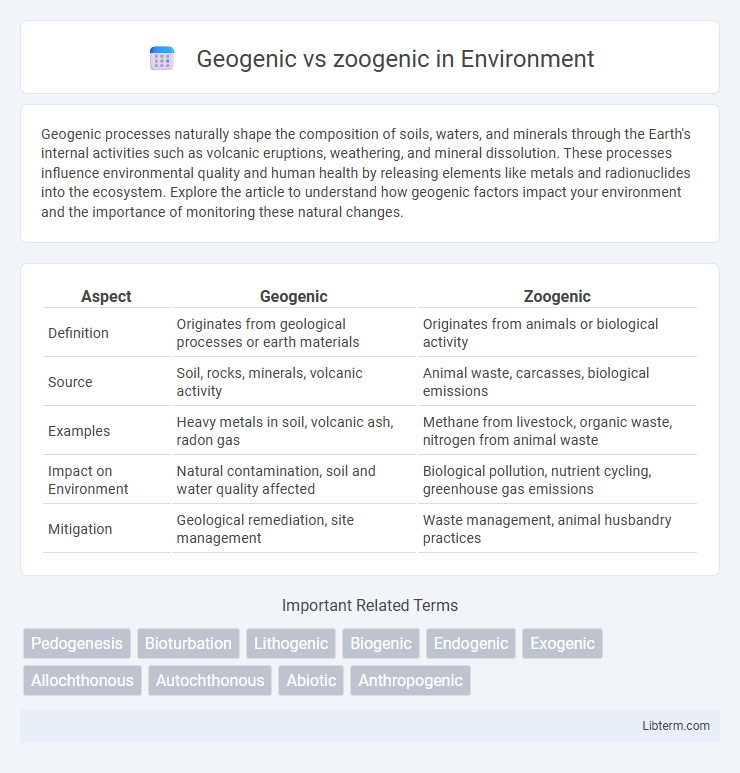Geogenic processes naturally shape the composition of soils, waters, and minerals through the Earth's internal activities such as volcanic eruptions, weathering, and mineral dissolution. These processes influence environmental quality and human health by releasing elements like metals and radionuclides into the ecosystem. Explore the article to understand how geogenic factors impact your environment and the importance of monitoring these natural changes.
Table of Comparison
| Aspect | Geogenic | Zoogenic |
|---|---|---|
| Definition | Originates from geological processes or earth materials | Originates from animals or biological activity |
| Source | Soil, rocks, minerals, volcanic activity | Animal waste, carcasses, biological emissions |
| Examples | Heavy metals in soil, volcanic ash, radon gas | Methane from livestock, organic waste, nitrogen from animal waste |
| Impact on Environment | Natural contamination, soil and water quality affected | Biological pollution, nutrient cycling, greenhouse gas emissions |
| Mitigation | Geological remediation, site management | Waste management, animal husbandry practices |
Understanding Geogenic and Zoogenic: Definitions
Geogenic refers to processes, substances, or features originating from geological or earth-based sources, such as minerals formed through volcanic activity or natural rock weathering. Zoogenic pertains to origins related to animals, including biological materials like animal waste or remains that influence ecosystems or soil composition. Understanding the distinction between geogenic and zoogenic factors is essential for environmental studies, mineralogy, and ecosystem analysis to accurately assess natural versus biological impacts.
Origins of Geogenic and Zoogenic Processes
Geogenic processes originate from the Earth's internal geological activities such as volcanic eruptions, tectonic movements, and mineral formation, driven by geothermal energy and the planet's natural composition. Zoogenic processes arise from biological activities of animals, including waste production, respiration, and decomposition, influencing soil and sediment composition through organic matter deposition. Understanding the distinct origins of geogenic and zoogenic processes is crucial for environmental studies, revealing the interplay between abiotic and biotic factors in ecosystem dynamics.
Key Differences Between Geogenic and Zoogenic Sources
Geogenic sources originate from natural geological processes such as volcanic activity, rock weathering, and mineral deposits, while zoogenic sources stem from animal activities including waste production and microbial metabolism. Geogenic contamination often involves heavy metals and inorganic compounds naturally released into the environment, whereas zoogenic contamination mainly consists of organic matter, pathogens, and nutrients from animal origins. Understanding these distinctions is crucial for targeted environmental management and pollution control strategies in ecosystems.
Geogenic Factors Shaping the Environment
Geogenic factors shaping the environment include natural processes such as volcanic activity, tectonic movements, and chemical weathering that alter landscapes and influence soil composition. These geological phenomena contribute to the formation of minerals, landforms, and natural habitats essential for ecosystem diversity. Understanding geogenic influences is crucial for assessing natural hazards and managing environmental sustainability.
Zoogenic Influences on Ecosystems
Zoogenic influences on ecosystems primarily stem from animal activities such as grazing, burrowing, and nutrient cycling, which directly shape soil composition and plant community structure. These biological processes drive heterogeneity in habitats by altering nutrient availability and promoting biodiversity through seed dispersal and predator-prey dynamics. Understanding zoogenic impacts is crucial for ecosystem management and conservation, as animals regulate ecological balance and contribute to habitat resilience against environmental changes.
Examples of Geogenic Substances and Their Impact
Geogenic substances such as arsenic, radon, and heavy metals naturally occur due to geological processes and can significantly impact environmental and human health through groundwater contamination and soil toxicity. Radon gas, emanating from radioactive decay in rocks like granite, is a leading cause of lung cancer after smoking. Elevated levels of arsenic in well water, common in regions with certain sedimentary deposits, contribute to chronic poisoning and increased cancer risks.
Common Zoogenic Materials and Their Roles
Common zoogenic materials include shells, bones, and organic remains derived from animal life, playing crucial roles in soil formation and sediment composition. These materials contribute to nutrient cycling, providing essential elements like calcium and phosphorus that enhance soil fertility and support plant growth. Zoogenic components also influence habitat structure by forming substrates in aquatic and terrestrial ecosystems, promoting biodiversity and ecosystem stability.
Environmental Implications of Geogenic vs Zoogenic Contributions
Geogenic contributions, originating from natural geological processes such as volcanic activity or rock weathering, often introduce trace elements and minerals into ecosystems, influencing soil and water quality. Zoogenic sources, derived from animal activity and biological waste, primarily affect nutrient cycling and organic matter distribution, impacting local biodiversity and ecosystem health. Understanding the balance between geogenic and zoogenic inputs is crucial for assessing contamination risks and managing sustainable environmental practices.
Methods for Differentiating Geogenic and Zoogenic Origins
Differentiating geogenic from zoogenic origins primarily involves isotopic analysis and mineralogical examination to identify source-specific signatures. Geogenic materials typically exhibit stable isotope ratios and trace element patterns consistent with natural geological processes, while zoogenic sources show distinct biological markers such as collagen or chitin residues. Advanced techniques like scanning electron microscopy (SEM) paired with energy-dispersive X-ray spectroscopy (EDX) further enhance differentiation by analyzing morphological features and elemental composition unique to either geogenic sediments or faunal remains.
The Importance of Recognizing Geogenic and Zoogenic Interactions
Understanding geogenic and zoogenic interactions is crucial for accurately assessing ecosystem dynamics and environmental impacts. Geogenic processes originate from geological sources such as soil, minerals, and rock formations, while zoogenic processes stem from animal activities, including waste deposition and burrowing behaviors. Recognizing how these natural sources interact informs effective environmental management, pollution control, and biodiversity conservation strategies.
Geogenic Infographic

 libterm.com
libterm.com